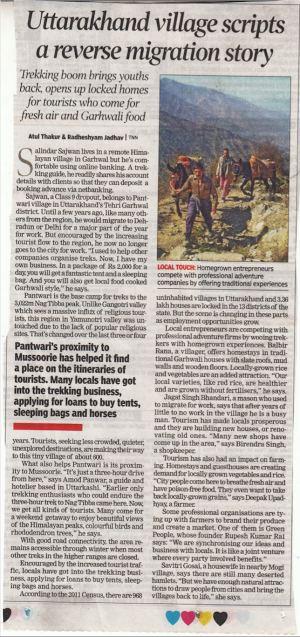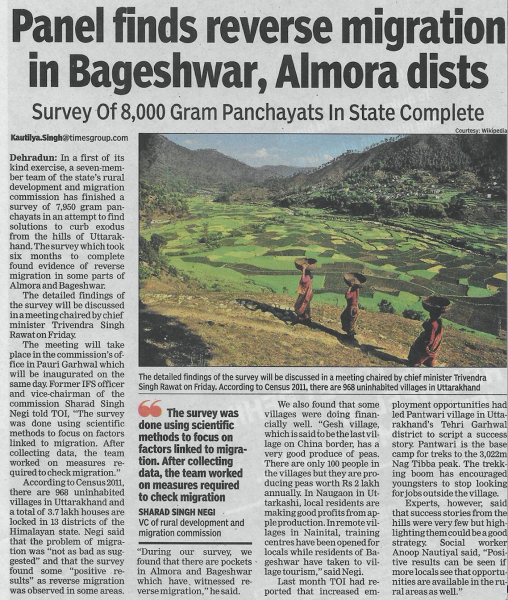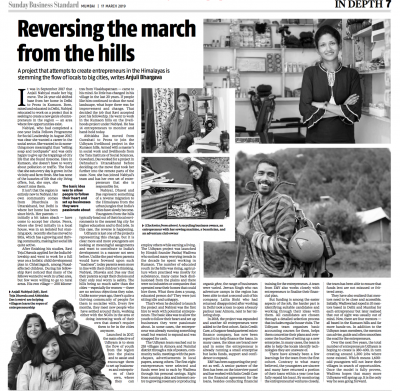Why Uttarakhand?
Uttarakhand is slowly scripting a reverse migration story, but we still have a long way to go.
Moving to the cities is neither a long-term nor a sustainable solution for the people of Uttarakhand. There has been recent evidence that those who migrated for employment to nearby towns and cities are slowly looking to make their way back to their hometowns or villages.
Udhyam also received a number of applications from those who had relocated for work and were looking to move back to start a business or enterprise.
This makes the realistic opportunity for self-employment and entrepreneurship all the more critical in order to create local employment as well as an enabling environment for aspiring entrepreneurs to be able to take the leap of faith required for setting up their own local business in their villages.
Uttarakhand, entrepreneurship and reverse migration in the news
Every year, thousands of young men from the hills, with a prayer on their lips and hopes in their heart, move to either the districts on plain lands or in the neighbouring states, to fulfill their dreams. Most of them end up doing petty jobs and living in small quarters.
A recent report of the Rural Development and Migration Commission cited a detailed study which pointed out that most economic opportunities tended to concentrate on the plain areas of the state, leading to huge income inequalities between plainland residents and those in the hills….
Read more here.
As modern jobs evade the state, rural millennials continue a pattern of out-migration that leaves hundreds of villages abandoned, or populated only by the elderly…..
Read more here.
For over 10 years, former army man Shyam Prasad was the last man standing at his Baluni village in Uttarakhand’s Pauri Garhwal district so it didn’t turn into a ‘ghost village’. But one day, the 69-year-old had to part ways with his land because of an illness.
There are many Shyam Prasads in the hill state, where the concept of a ‘ghost village’ has become a reality today. The villages that wear a deserted look because of increasing migration from Uttarakhand became uninhabited due to lack of public amenities….
Read more here.


About two decades after its formation, Uttarakhand finally has its tourism policy that aims to “facilitate reverse migration” to the fast emptying-out hills by promoting village-based tourism. The policy also aims to tap the hill state’s potential for wellness and adventure tourism.
“It aims to facilitate reverse migration to the fast emptying out hills by creating entrepreneurship avenues for the local youth in the tourism sector.”
Read more here.
The Rural Development and Migration Commission, set up by Chief Minister Trivendra Singh Rawat in 2017, released its survey report early last year. In the past decade, 1,18,981 people from 3,946 gram panchayats migrated permanently, and 3,83,726 people from 6,338 gram panchayats shifted temporarily (they visit their homes but live outside the state for work).
“”The educated are the first to leave as they get good jobs in cities and settle there… What is one to do when there aren’t many options for livelihood in the village?”
Read more here.
Across Uttarakhand, migration from the hilly areas has left scores of villages empty, so much so that the villages have earned the moniker of ‘ghost villages’.
The rate of migration from Mason has increased in the past decade. Rachna says that her son, now 11, completed his primary studies in a school in Mason which then had about 50 students from three villages. Today, crumbling walls and locked doors greet visitors to the school. The lone government inter-college in the region is also on the brink of closing due to lack of students.
Read more here.
SUNDAY BUSINESS STANDARD
A project that attempts to create entrepreneurs in the Himalayas is stemming the flow of locals to big cities.
Nabiyal, Dhaval and Das represent something of a reverse migration to the Himalayas from the urban jungles that India’s cities have become.
Read more here.

It’s been 18 years since Uttarakhand was carved out of Uttar Pradesh, but poor road connectivity in its remote hilly areas is leading to mass exodus and empty villages. Dinesh Mahtolia is a professional trainer and motivator hailing from Uttarakhand’s Bhadrakot village in Nainital; unfortunately, there is little about his own hometown that motivates him: more than 50 percent of the residents, including the Mahtolias, have long since migrated from the village, when we spoke to him. Reason: it’s been 18 years since Uttarakhand came into existence, but Mahtolia’s native place still lacks road connectivity, as do thousands of others.
Read more here.